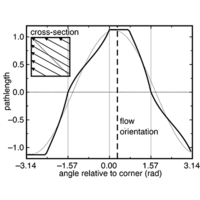当前位置:
X-MOL 学术
›
Phys. Rev. Fluids
›
论文详情
Our official English website, www.x-mol.net, welcomes your feedback! (Note: you will need to create a separate account there.)
Oscillation in the temperature profile of the large-scale circulation of turbulent convection induced by a cubic container
Physical Review Fluids ( IF 2.7 ) Pub Date : 2020-06-18 , DOI: 10.1103/physrevfluids.5.063501 Dandan Ji , Eric Brown
Physical Review Fluids ( IF 2.7 ) Pub Date : 2020-06-18 , DOI: 10.1103/physrevfluids.5.063501 Dandan Ji , Eric Brown

|
We present observations of oscillations in the shape of the temperature profile of the large-scale circulation (LSC) of turbulent Rayleigh-Bénard convection. Temperature measurements are broken down into Fourier moments as a function of , where is the azimuthal angle in a horizontal plane at midheight, and is the LSC orientation. The oscillation structure is dominated by a third-order sine moment and third-order cosine moment in a cubic cell. In contrast, these moments are not found to oscillate in a cylindrical cell. This geometry-dependent behavior can be explained by a minimal model that assumes that the heat transported by the LSC is conducted from the thermal boundary layers, and is proportional to the pathlength of the LSC along boundary layers at the top and bottom plates. In a noncircular cross-section cell, oscillations of the LSC orientation result in an oscillation in the container shape in the reference frame of the LSC, resulting in an oscillation in the pathlength of the LSC at a given . In a square-cross-section cell, this model predicts the dominant third-order sine moment and third-order cosine moment with magnitudes within 50% of measured values, when using the amplitude of the oscillation of as input. A cylindrical cell is special in that the pathlength is independent of , and so these oscillating moments are not induced. In a cylindrical cell, the model reproduces the sinusoidal mean temperature profile with a sloshing oscillation dominated by the second-order sine moment, consistent with previous observations in that geometry.
中文翻译:

立方容器引起的湍流对流大规模循环温度曲线的振荡
我们提出了湍流瑞利-贝纳德对流的大规模循环(LSC)温度曲线形状中的振动观测。温度测量可分解为傅立叶矩,在哪里 是在中高度的水平面中的方位角,并且 是LSC方向。立方晶胞中的振动结构主要由三阶正弦矩和三阶余弦矩决定。相反,未发现这些力矩在圆柱单元中振荡。这种与几何形状有关的行为可以通过一个最小模型来解释,该模型假设LSC传输的热量是从热边界层传导的,并且与LSC沿着顶板和底板的边界层的路径长度成比例。在非圆形横截面单元中,LSC方向的振荡 导致LSC参照系中的容器形状发生波动,从而导致给定LSC路径长度的波动 。在正方形截面的单元中,当使用振动的振幅时,该模型可以预测主要的三阶正弦矩和三阶余弦矩,其幅度在测量值的50%以内。作为输入。圆柱单元的特殊之处在于光程长度与,因此不会产生这些振荡力矩。在圆柱单元中,该模型可再现正弦平均温度曲线,并具有以二阶正弦矩为主的晃动振荡,这与先前在该几何中的观察结果一致。
更新日期:2020-06-18
中文翻译:

立方容器引起的湍流对流大规模循环温度曲线的振荡
我们提出了湍流瑞利-贝纳德对流的大规模循环(LSC)温度曲线形状中的振动观测。温度测量可分解为傅立叶矩,在哪里 是在中高度的水平面中的方位角,并且 是LSC方向。立方晶胞中的振动结构主要由三阶正弦矩和三阶余弦矩决定。相反,未发现这些力矩在圆柱单元中振荡。这种与几何形状有关的行为可以通过一个最小模型来解释,该模型假设LSC传输的热量是从热边界层传导的,并且与LSC沿着顶板和底板的边界层的路径长度成比例。在非圆形横截面单元中,LSC方向的振荡 导致LSC参照系中的容器形状发生波动,从而导致给定LSC路径长度的波动 。在正方形截面的单元中,当使用振动的振幅时,该模型可以预测主要的三阶正弦矩和三阶余弦矩,其幅度在测量值的50%以内。作为输入。圆柱单元的特殊之处在于光程长度与,因此不会产生这些振荡力矩。在圆柱单元中,该模型可再现正弦平均温度曲线,并具有以二阶正弦矩为主的晃动振荡,这与先前在该几何中的观察结果一致。



























 京公网安备 11010802027423号
京公网安备 11010802027423号